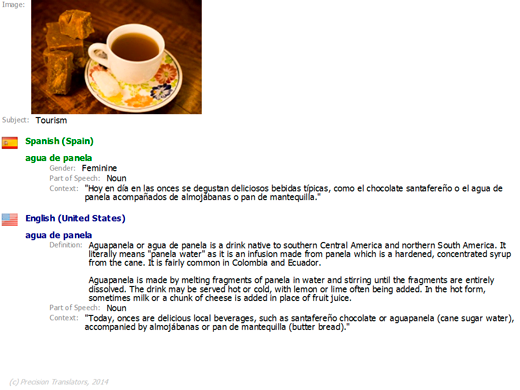As technology evolves, translation does too. Ttherefore, the translator work not only depends on the human factor, but the efficient use of technology resources thatwere designed with the purpose of contributing to the success of this activity. One of these resources are the Termbases (BT).
What is a termbase?
A termbase is more than a dictionary; it is a is a database that contains terms (madeup of one or more words, In one or more languages) and also related information such as linguistic equivalents, definitions, context of use, synonyms, grammatical information, acronyms, levels of approval for the terms, notes, and even related images. Generally, the TB Generally, the TB specializes in the language inherent to a specific field of study.
Thetermbases can be found on line for free or by subscription or can be created using CAT (Computer Assisted Translation) Tools or (herramientas de Traducción Asistida por Computador, such as SDL Trados Studio and Déjà Vu.

Example of an entry in a term base
We highly recommend managing termbases when…
- The topic of a translation is complex or has a great deal of specialized terms
- The translation’s volume is considerable
- The client requires frequent translation services
- A team of translators is involved in a project
- The translation is made into several languages
- The client has specific language preferences
How to manage a termbase?
- By ensuring that all TB entries have complete information from the established fields; for example, the definition, context of use, images, etc.
- By clearly communicating to the people in charge of updating the TB of the terms and modifications requested by the client. It is important to make these changes immediately in order to respect client preferences.
- Sharing it with the client in order to validate together those terms added during the translation process.
Once the person in charge of managing the termbase completes these tasks, he or she must share it as reference material with the linguists taking part in the project. If a TB is not managed efficiently, it will lose its value.
Managing termbases can be done simultaneously with the translation process. In this case, the translator adds key terms or terms used several times throughout the documents. This is a simple and quick task because the translator can view the original text, translated text and the termbase in the same environment.
It is very common to find companies using technical terminology made up of common words with a particular meaning. That’s why,they develop corporate glossaries to unify language inside the company, facilitate its usage and understanding among employees. The glossaries can be used to create a termbase. When a company does not have a glossary, the translation service provider can create the term base as a service.
Advantages of using termbases
| For the translator | What this means for a client |
| Consistent language
Consistency in all texts translated, regardless of the Department requesting the translation, when or how many translators are involved in a project.
|
The client‘s corporate image is properly maintained and transmitted in the languages of its target markets, thereby protecting its brand.
Example: The term server can be translated in Spanish as “servidor”, however some companies prefer to use the term in English. Upon agreement with the client, this term should be added to the TB and used when translating documents from this particular client, even when using “servidor” would be correct.
|
| Accurate translations.
The TB contains terms that have been researched by linguists in the process of creating the termbase or are approved by the client, so the translator is able to use them with the certainty that this translation is adequate, faithful to the original language and context, and in keeping with client requirements. |
Get a translation of yourdocuments that is adequate, faithful to the original language and context, and inwith client requirements.
Example: Proper use of product names in other markets |
| Higher productivity.
The translator is more productive because instead of spending time researching terms, he can use the terms from the TB, which have already been researched. |
Get translated documents in less time. |
Extra benefit of managing termbases:
ATB can be shared not only with a translators team, but also with the client.. This collaborative work will allow to agree on term equivalents and meaning that should be used, and to edit existing terms. As a result, the TB will be updated the client’s preferences.
In conclusion…
Managing termbases is a proactive, multi-disciplinary team process that contributes to transmitting accurate, effective, quality messages that allow the client to have proper communication, and the Language Service Provider to optimize its processes.
